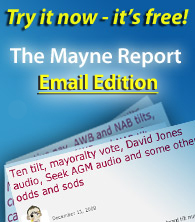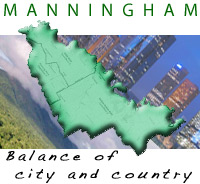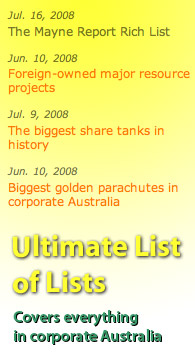Ranking the most biased corporate ballot papers
September 24, 2024
This list ranks the companies starting with the worst when it comes to biased ballot papers in contested corporate elections. And see below for some best practice examples of how it should be done.
ANZ 2013: David Barrow received the most unfair treatment from ANZ with the blue highlighter separating out the election and excessively pushing "against" and "non-board endorsed".
Macquarie 2015 (p26): Very unfair but not quite as bad as ANZ given challenger Stephen Mayne has not been relegated to the very bottom of the page like ANZ did to David Barrow.
AFIC 2013 (p142): The column directing voting down the left hand side against Stephen Mayne was very unfair.
Westpac 2013: David Barrow was given his own resolution number 6 at the bottom whereas the incumbents were 5a/b/c/d. Bold recommendation against near his voting box.
NAB 2013: at least David Barrow was 5d but there was clearly no drawing of lots but the separation by inserting the chairman's voting intention was very unfair.
NAB 2009: clearly didn't determine the order by lot, as Stephen Mayne was at the bottom under a thick black line separating all the other incumbent directors.
Cabcharge 2014: boxes evenly spaced but Stephen Mayne was last with a big bold ELECTION OF NON-BOARD ENDORSED CANDIDATE directly next to the voting boxes.
Commonwealth Bank 2014: unfair numbering, no ballot on position and a bold disendorsement right next to the "for" box. Very poor form.
Fairfax Media 2014: numbering and spacing okay but no ballot on the draw and a bolded "non-board endorsed candidate" right next to Stephen Mayne's name.
Ten Network Holdings 2014: numbering okay but unfair to have challenger Stephen Mayne last without a draw and at the top of the second column, complete with board's non-endorsement.
MAP 2010 (p15): introduced a chairman's proxy message directly next to the voting boxes which was bad form by Max Moore-Wilton. Also no sign of drawing lots for voting order with Stephen Mayne last.
Gunns 2005 (p8): the ballot paper itself was reasonably clean but the rort was telling shareholders it was invalid to vote in favour of all three candidates. This increased undirected proxies which were used against Stephen Mayne.
WA News 2007: the numbering and ballot boxes were okay but they went very big and bold at the bottom on the chairman's intentions to oppose Stephen Mayne.
Rio Tinto 2011: put Stephen Mayne last of 13 candidates with no ballot draw and had a gap before item 15 and then the word "against" appears directly under the "for" box.
Woolworths 2006 (p182): the numbering was fine and Stephen Mayne wasn't the last candidate but there was a bolded message on chairman's proxy intention, plus a "no vacancy" message that it was invalid to vote in favour of all five candidates.
Alumina 2008 (p10): all fine with the exception of the bolded capitals explaining the chairman's voting intentions straight below the last of the voting boxes, although at least Stephen Mayne's candidacy was in the middle.
BHP Billiton 2008: with 34 resolutions the opportunity for rorting is reduced and this was a fair ballot paper besides the bold chairman's recommendation against Stephen Mayne printed prominently at the top.
Macquarie Bank 2006: fair spacing and numbering although not clear that was from a ballot draw. Only minor quibble with bolded chairman proxy advice saying would oppose item 5, but doesn't name Stephen Mayne like BHP did in 2008 (see above).
Woolworths 2014 (p4): positions on ballot were drawn, numbering and spacing fine and even the proxy advice was in relatively small bold print below the second proxy boxes.
IMF 2012 (p14): David Barrow challenge was treated fairly with non-bolded proxy advice in fine print well below the voting boxes.
Woolworths 2010: a ballot was held for candidate list and numbering was fine along with spacing. Chairman's proxy advice was very fine print and no bold or use of the word "against", but there was a mention of "no vacancy" on the ballot paper.
Santos 2011: perfectly fair numbering and box placement and just a bolded AGAINST underneath explaining the chairman's intentions but not too bad in the circumstances.
WA News 2008 EGM: 15 resolution with the board opposed to the 4 removals put up by Kerry Stokes plus the 11 candidates who nominated. Board recommendation was a bit too large in bold at the bottom, but understandable.
IAG 2014 (p15): Michael Carlin challenged the board and was treated quite well, placed in the middle of the field with no separation of ballot boxes. Board recommendation against was in bold but this was well above the voting boxes.
Finally, here are 6 examples of fair ballot papers when there has been a candidate opposed by the board.
AMP 2003: Stephen Mayne ran for the board after it almost went broke and the ballot paper was completely fair with the 8 candidates listed from 2a to 2h and Stephen Mayne appearing in the middle, indistinguishable from everyone else.
Aristocrat 2004: former chairman John Ducker was opposed by the rest of the board but there was no clue on the proxy form.
AWB 2009: only two candidates for the board, Tony Howarth and Stephen Mayne, and it was indistinguishable on the ballot paper as to who was endorsed and who wasn't.
Centro Retail 2008 (p15): a perfectly fair ballot paper and the only one of Stephen Mayne's 55 tilts where the ballot paper has said "the chairman intends to vote undirected proxies in favour of all items". Chair Paul Cooper could say this because he knew parent company Centro Property Group would be voting its controlling stake against my election, but I still managed a healthy 26.7% in the final vote.
ASX 2008: there was a bold red message warning that there was only two vacancies and three candidates but nothing on the ballot paper itself urging a vote against Stephen Mayne or saying the chairman would vote undirected proxies against him.
Tassal 2011: Rudi Tsai was nominated by a shareholder and the board made no recommendation and simply said in fine print on the ballot paper that undirected proxies would not be voted on this item. Long serving incumbent director Jill Monk was voted off the board on the same day Mr Tsai got elected.
Copyright © 2024 The Mayne Report. All rights reserved






















